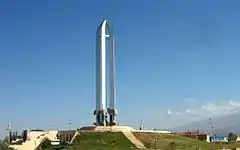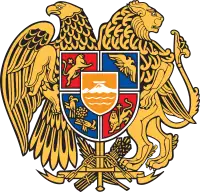انکار نسلکشی ارمنیها
انکار نسلکشی ارمنیها ادعایی است مبنی بر این که امپراتوری عثمانی و حزب حاکم بر آن، حزب اتحاد و ترقی، مرتکب نسلکشی شهروندان ارمنی خود در دوران جنگ جهانی اول نشدهاند؛ جنایتی که مدارک بسیاری از آن باقیمانده و اکثریت قریب به اتفاق پژوهشگران آن را تأیید کردهاند.[2][3] عاملان این نسلکشی در هنگام انجام آن، رخدادش را انکار کردند و ادعا کردند که ارامنه به دلایل نظامی جابهجا شده و آنها را نابود نکردهاند. در پی این نسلکشی، اسناد و مدارک مجرمانه بهطور سیستماتیکی تخریب شد و انکار آن سیاست هر دولت جمهوری ترکیه تا تاریخ ۲۰۲۱ بود.

حزب اتحاد و ترقی استدلالهایی را برای توجیه اقدامات خود به کار گرفتهاست و انکار آنها بر این فرض است که «جابجایی» ارامنه اقدام قانونی دولت در پاسخ به قیام واقعی یا قابلتصور ارمنیها بود که وجود امپراتوری را در زمان جنگ تهدید میکرد. انکارکنندگان اظهار داشتند این حزب به جای کشتن ارمنیها، آنها را جابهجا کردهاست. آنها ادعا میکنند که شمار کشتهشدگان اغراقآمیز است یا علت اصلی این مرگ و میرها عواملی مانند جنگ داخلی ادعاشده، بیماری، شرایط بد آبوهوایی، مقامات محلی سرکش یا گروههای کرد و یاغی بودهاست. تاریخنگار رونالد گریگور سانی اظهار داشت که بحث اصلی این است که «هیچ نسلکشی در کار نبوده و ارمنیان مقصر آن بودهاند.»[4] این انکار معمولاً با «سخنانی در مورد خیانت ارمنیها، تجاوز، جنایت و جاهطلبی ارضی آنها» همراه است.[5]
یکی از مهمترین دلایل این انکار این است که این نسلکشی امکان ایجاد یک دولت ملی ترکیهای را فراهم کرد و به رسمیت شناختن آن با اسطورههای بنیانگذار ترکیه مغایرت دارد.[6] ترکیه از دهه ۱۹۲۰ تلاش کردهاست تا از به رسمیت شناختن رسمی یا حتی ذکر نسلکشی در سایر کشورها جلوگیری کند. این تلاشها شامل صرف میلیونها دلار برای لابی، ایجاد موسسات پژوهشی، ارعاب و تهدید میشود. انکار این نسلکشی همچنین بر سیاستهای داخلی ترکیه تأثیر میگذارد و در مدارس ترکیه تدریس میشود. برخی از شهروندان ترکیه که نسلکشی را تأیید میکنند به دلیل «توهین به ترکیهای بودن» تحت پیگرد قانونی قرار گرفتهاند. تلاش یک قرنی دولت ترکیه در انکار نسلکشی، این کشور را از سایر موارد نسلکشی در تاریخ متمایز میکند.[7] جمهوری آذربایجان نیز این نسلکشی را انکار و علیه شناسایی آن در سطح بینالمللی مبارزه میکند. بیشتر شهروندان و احزاب سیاسی ترکیه در این کشور از سیاست انکار دولت حمایت میکنند. انکار نسلکشی به مناقشه قرهباغ و همچنین خشونت مداوم علیه کردها در ترکیه نیز کمک میکند.
پانویس
-
- Marchand, Laure; Perrier, Guillaume (2015). Turkey and the Armenian Ghost: On the Trail of the Genocide. McGill-Queen's Press. pp. 111–112. ISBN 978-0-7735-9720-4.
The Iğdır genocide monument is the ultimate caricature of the Turkish government's policy of denying the 1915 genocide by rewriting history and transforming victims into guilty parties.
- Hovannisian 2001, p. 803.
- Cheterian 2015, pp. 65–66
- Gürpınar 2016, p. 234
- Marchand, Laure; Perrier, Guillaume (2015). Turkey and the Armenian Ghost: On the Trail of the Genocide. McGill-Queen's Press. pp. 111–112. ISBN 978-0-7735-9720-4.
- Dadrian 2003, pp. 270–271; Chorbajian 2016, p. 168;
- Ihrig 2016, pp. 10–11
- Gürpınar 2016, p. 234
- Cheterian 2018a, p. 189
- Academic consensus:
- Bloxham, Donald (2003). "Determinants of the Armenian Genocide". Looking Backward, Moving Forward. Routledge. pp. 23–50. doi:10.4324/9780203786994-3. ISBN 978-0-203-78699-4.
Despite growing scholarly consensus on the fact of the Armenian Genocide...
- Suny 2009, p. 935
- Göçek 2015, p. 1
- Smith 2015, p. 5
- Laycock, Jo (2016). "The Great Catastrophe". Patterns of Prejudice. 50 (3): 311–313. doi:10.1080/0031322X.2016.1195548.
... important developments in the historical research on the genocide over the last fifteen years... have left no room for doubt that the treatment of the Ottoman Armenians constituted genocide according to the United Nations Convention on the Prevention and Punishment of Genocide.
- Kasbarian, Sossie; Öktem, Kerem (2016). "One Hundred Years Later: the Personal, the Political and the Historical in Four New Books on the Armenian Genocide". Caucasus Survey. 4 (1): 92–104. doi:10.1080/23761199.2015.1129787.
... the denialist position has been largely discredited in the international academy. Recent scholarship has overwhelmingly validated the Armenian Genocide...
- "Taner Akçam: Türkiye'nin, soykırım konusunda her bakımdan izole olduğunu söyleyebiliriz". CivilNet (به ترکی استانبولی). 9 July 2020. Retrieved 19 December 2020.
- Bloxham, Donald (2003). "Determinants of the Armenian Genocide". Looking Backward, Moving Forward. Routledge. pp. 23–50. doi:10.4324/9780203786994-3. ISBN 978-0-203-78699-4.
- Suny 2015, pp. xii–xiii
- Bloxham 2005, p. ۲۳۴.
- Foundational violence:
- Bloxham 2005, p. 111
- Kévorkian 2011, p. 810
- Göçek 2015, p. 19
- Suny 2015, pp. 349, 365
- Kieser, Hans-Lukas; Öktem, Kerem; Reinkowski, Maurus (2015). "Introduction". World War I and the End of the Ottomans: From the Balkan Wars to the Armenian Genocide. Bloomsbury Publishing. ISBN 978-0-85772-744-2.
We are of the firm opinion, strengthened by the contributions in this volume, that the single most important reason for this inability to accept culpability is the centrality of the Armenian massacres for the formation of the Turkish nation-state. The deeper collective psychology within which this sentiment rests assumes that any move toward acknowledging culpability will put the very foundations of the Turkish nation-state at risk and will lead to its steady demise.
- Chorbajian 2016, p. 169
- Distinctiveness of Turkish denial efforts:
- Smith, Roger W. (2006). "The Significance of the Armenian Genocide after Ninety Years". Genocide Studies and Prevention. 1 (2): i–iv. doi:10.3138/G614-6623-M16G-3648.
The Armenian Genocide, in fact, illuminates with special clarity the dangers inherent in the political manipulation of truth through distortion, denial, intimidation, and economic blackmail. In no other instance has a government gone to such extreme lengths to deny that a massive genocide took place.
- Avedian 2013, p. 79
- Akçam 2018, pp. 2–3
- Tatz, Colin (2018). "Why is the Armenian Genocide not as well known?". In Bartrop, Paul R. Modern Genocide: Analyzing the Controversies and Issues. ABC-CLIO. p. 71. ISBN 978-1-4408-6468-1.
Uniquely, the entire apparatus of a nation-state has been put to work to amend, ameliorate, deflect, defuse, deny, equivocate, justify, obfuscate, or simply omit the events. No other nation in history has so aggressively sought the suppression of a slice of its history, threatening everything from breaking off diplomatic or trade relations, to closure of air bases, to removal of entries on the subject in international encyclopedias.
- Smith, Roger W. (2006). "The Significance of the Armenian Genocide after Ninety Years". Genocide Studies and Prevention. 1 (2): i–iv. doi:10.3138/G614-6623-M16G-3648.
منابع
- Hovannisian, Richard G. (2015). "Denial of the Armenian Genocide 100 Years Later: The New Practitioners and Their Trade". Genocide Studies International. 9 (2): 228–247. doi:10.3138/gsi.9.2.04.
- Cheterian, Vicken (2015). Open Wounds: Armenians, Turks and a Century of Genocide. Hurst. ISBN 978-1-84904-458-5.
- Gürpınar, Doğan (2016). "The Manufacturing of Denial: the Making of the Turkish 'Official Thesis' on the Armenian Genocide Between 1974 and 1990". Journal of Balkan and Near Eastern Studies. 18 (3): 217–240. doi:10.1080/19448953.2016.1176397.
- Chorbajian, Levon (2016). "'They Brought It on Themselves and It Never Happened': Denial to 1939". The Armenian Genocide Legacy. Palgrave Macmillan UK. pp. 167–182. ISBN 978-1-137-56163-3.
- Dadrian, Vahakn N. (2003). "The Signal Facts Surrounding the Armenian Genocide and the Turkish Denial Syndrome". Journal of Genocide Research. 5 (2): 269–279. doi:10.1080/14623520305671.
- Ihrig, Stefan (2016). Justifying Genocide: Germany and the Armenians from Bismarck to Hitler. Harvard University Press. ISBN 978-0-674-50479-0.
- Suny, Ronald Grigor (2009). "Truth in Telling: Reconciling Realities in the Genocide of the Ottoman Armenians". The American Historical Review. 114 (4): 930–946. doi:10.1086/ahr.114.4.930.
- Göçek, Fatma Müge (2015). Denial of Violence: Ottoman Past, Turkish Present and Collective Violence Against the Armenians, 1789–2009. Oxford University Press. ISBN 978-0-19-933420-9.
- Smith, Roger W. (2015). "Introduction: The Ottoman Genocides of Armenians, Assyrians, and Greeks". Genocide Studies International. 9 (1): 1–9. doi:10.3138/gsi.9.1.01.
- Bloxham, Donald (2005). The Great Game of Genocide: Imperialism, Nationalism, and the Destruction of the Ottoman Armenians. Oxford University Press. ISBN 978-0-19-922688-7.
- Kévorkian, Raymond (2011). The Armenian Genocide: A Complete History. Bloomsbury Publishing. ISBN 978-0-85771-930-0.
- Avedian, Vahagn (2013). "Recognition, Responsibility and Reconciliation: The Trinity of the Armenian Genocide". Europa Ethnica. 70 (3/4): 77–86. doi:10.24989/0014-2492-2013-34-77. ISSN 0014-2492.
- Akçam, Taner (2018). Killing Orders: Talat Pasha's Telegrams and the Armenian Genocide. Palgrave Macmillan. ISBN 978-3-319-69787-1.

